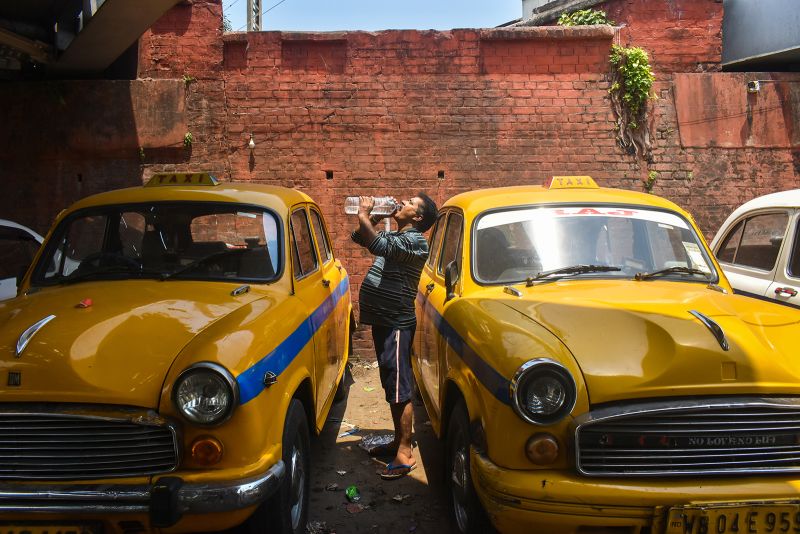
Indian voters battle extreme temperatures as intense heat wave hits region
Indian voters are battling sweltering conditions to take part in the world’s biggest election as a severe heat wave hits parts of the country and authorities forecast a hotter-than-normal summer for the South Asian nation.
The India Meteorological Department (IMD) said a heat wave will affect parts of south and east India until the end of the week, including four states that are voting on Friday.
Parts of West Bengal, Bihar, Uttar Pradesh and Karnataka are among 13 states and union territories voting in the second phase of India’s mammoth elections, with temperatures forecast to exceed 40 degrees Celsius (104 degrees Fahrenheit) in some areas.
On Thursday, Baripada in the eastern state of Odisha hit 43.6 C (110.4 F) and Telangana’s Khammam in the south reached 43.4 C (110.1 F), according to the IMD, which warned last month that India would likely see stronger and longer heat waves this year due to above-normal temperatures.
Gandhi Ray, a farmer in his 60s from eastern Bihar state, said he lives in a small hut in the forest, and will walk to a nearby village to vote.
Temperatures above 41 C (105 F) are forecast every day until May 1 in his hometown of Banka district, according to the IMD.
High temperatures have raised concern this election cycle, as campaigns marked by outdoor political rallies draw thousands of people under the baking sun. The issue was underscored Wednesday, when one lawmaker collapsed from the heat while addressing supporters in western Maharashtra state.
The Election Commission, National Disaster Management Authority and IMD formed a task force to minimize the impact of heat waves ahead of polling days and Prime Minister Narendra Modi chaired a meeting earlier this month to review the country’s preparedness for the hot season.
The Election Commission has released guidelines for staying cool at polling stations, including drinking water and carrying an umbrella, and warned against leaving children or pets in parked cars.
And in Bihar, election officials have extended voting hours at some polling stations “in view (of the) prevailing heat wave.”
Ray said the heat isn’t going to stop him from voting on Friday.
“This is the one right we have so of course I will vote, everyone should vote for whomever they want to represent them,” he said.
“Of course it would be good if the election took place in a cooler time but whether I go to vote or not, I am still going to feel hot so that’s not going to stop me.”
Despite the heat warnings, the Election Commision said there are “no major concerns for heat waves” during Friday’s polling and weather forecasts indicate “normal conditions” for the constituencies voting.
Climate politics
India, the world’s most populous nation with 1.4 billion people, often experiences heat waves during the summer months of May and June. But in recent years, they have arrived earlier and become more prolonged, with scientists linking some of these longer and more intense heat waves to the climate crisis.
In 2022, a heat wave that killed 90 people across India and Pakistan was made 30 times more likely because of climate change, the World Weather Attribution initiative found.
Last year successive heat waves hit India again, closing schools, damaging crops and putting pressure on energy supplies. In June alone, temperatures in some parts of the country soared to 47 C (116 F), killing at least 44 people and sickening hundreds with heat-related illnesses.
The human-caused climate crisis is already threatening India’s development goals and putting millions of people at risk in a nation where more than 50% of the workforce is employed in agriculture, studies have found. By 2050, India will be among the places where temperatures have passed survivability limits, according to climate experts.
But analysts say climate has not featured as a major issue this election, despite being mentioned in the election manifestos of the two main parties — the ruling Bharatiya Janata Party (BJP) and the Indian National Congress.
“You can see it in farmers asking for loan waivers and irrigation facilities after years of drought, in urban families demanding reduced electricity prices to offset cooling bills and in calls for more penetrating social welfare.”
Regional impact
Extreme heat has already had an impact across the region this year with little respite from merciless heat and humidity for hundreds of millions of people living in areas most vulnerable to climate change.
Neighboring Bangladesh is sweltering through a heat wave this week with prolonged temperatures above 40 C in many districts and no relief during record hot nights, according to climatologist Maximiliano Herrera. The government declared a “heat alert” across the country on Thursday, in place for 72 hours.
Extreme temperatures are also soaring across Southeast Asia, with dozens of heatstroke deaths report by local media in Thailand, hundreds of schools closed in the Philippines, and droughts drying up rice fields and rivers in Vietnam’s Mekong Delta “rice bowl” region.
The weeks-long heat wave in Vietnam has forced three provinces to declare a state of emergency as salt seeps into fresh water sources, limiting access to drinking water for more than 70,000 households, according to Save the Children.
A report released Tuesday by the World Meteorological Organization found that Asia remained the world’s most disaster-affected region in 2023 and the region is heating up faster than the global average.
